Airborne sensors offer unparalleled advantages for environmental health assessments. You'll get wide area coverage, real-time data collection, and cost-effective monitoring solutions. They can access hard-to-reach locations, provide high-resolution mapping, and offer versatile sensor payloads. You'll benefit from temporal and spatial flexibility, allowing for precise data collection at specific times and locations. These sensors also minimize environmental disturbance, ensuring ecosystems remain undisturbed during assessments. By using airborne sensors, you're employing cutting-edge technology that revolutionizes how we monitor and understand environmental health. Exploring this innovative approach further will reveal even more benefits for your assessment needs.
Wide Area Coverage
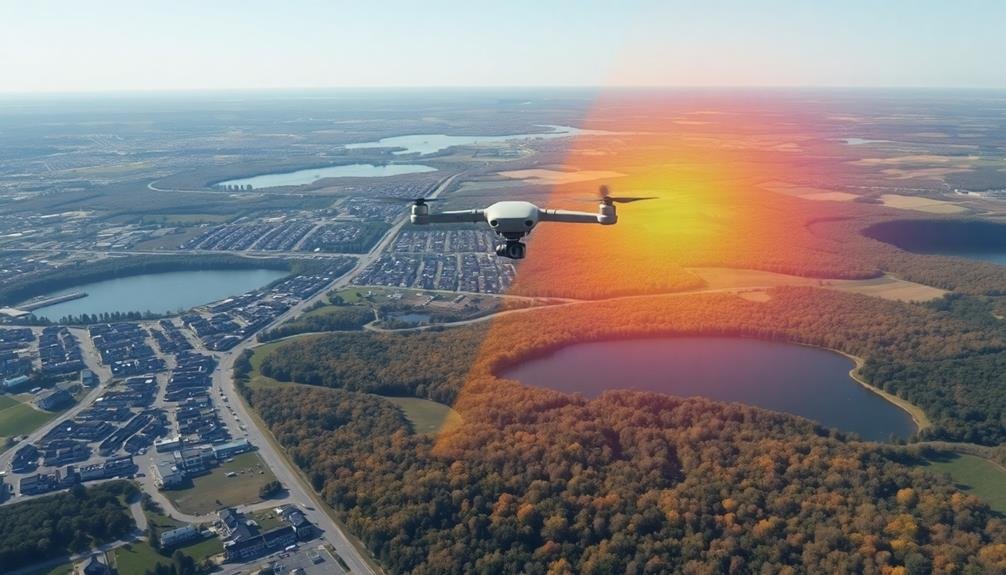
Frequently, airborne sensors provide unparalleled wide area coverage for environmental health assessments. When you're conducting these assessments, you'll find that airborne sensors can cover vast regions in a short amount of time. This efficiency is vital for monitoring large-scale environmental changes or tracking the spread of pollutants across extensive areas.
You'll appreciate how airborne sensors can capture data from remote or inaccessible locations. They can survey mountainous terrain, dense forests, or expansive water bodies that would be challenging or impossible to assess using ground-based methods. This thorough coverage guarantees you don't miss critical environmental factors that could impact public health.
Additionally, you'll find that airborne sensors offer a bird's-eye view of entire ecosystems. This perspective allows you to identify patterns and relationships that mightn't be apparent from ground level. You can easily detect variations in vegetation health, water quality, or air pollution across different regions, helping you pinpoint areas of concern for further investigation.
Real-Time Data Collection
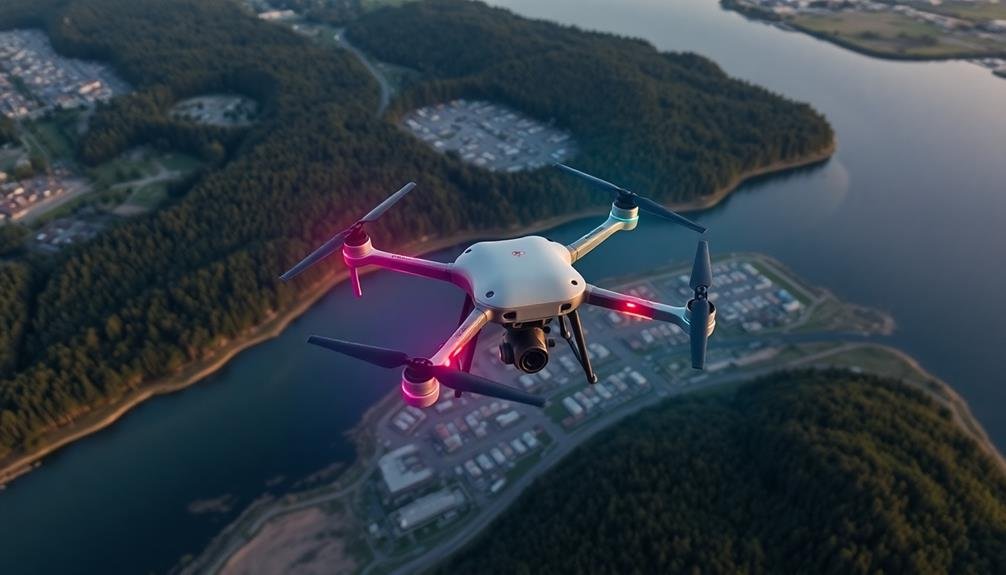
Real-time data collection from airborne sensors provides you with immediate environmental insights.
You'll receive up-to-the-minute information on air quality, pollutant levels, and other critical environmental factors.
This rapid access to data enables you to respond swiftly to emerging environmental concerns, enhancing your ability to protect public health and safety.
Immediate Environmental Insights
Airborne sensors consistently deliver immediate environmental insights through real-time data collection. You'll gain instant access to vital information about air quality, pollution levels, and atmospheric conditions.
These sensors can detect and measure various pollutants, such as particulate matter, ozone, nitrogen dioxide, and volatile organic compounds, providing you with an extensive picture of the environment's health.
With this real-time data, you're able to make informed decisions quickly. You can identify pollution hotspots, track the spread of contaminants, and monitor the effectiveness of environmental interventions.
This immediacy allows you to respond rapidly to emerging environmental threats, potentially preventing or mitigating adverse health effects on local populations.
Furthermore, you'll benefit from the ability to visualize environmental data in real-time through user-friendly interfaces and mapping tools.
This feature enables you to communicate complex environmental information to stakeholders, policymakers, and the public effectively.
Rapid Response Capabilities
Nearly instantaneous data collection from airborne sensors empowers you with rapid response capabilities. You'll be able to quickly evaluate environmental threats and take immediate action to protect public health.
These sensors can detect air pollutants, hazardous chemicals, and other environmental hazards in real-time, allowing you to respond swiftly to emergencies or sudden changes in air quality.
With airborne sensors, you're no longer limited by ground-based monitoring stations. You can cover large areas quickly and efficiently, identifying pollution hotspots or tracking the spread of contaminants.
This rapid data collection enables you to make informed decisions on the spot, such as issuing public health warnings or implementing emergency response protocols.
You'll also benefit from the ability to monitor hard-to-reach areas or dangerous environments without putting personnel at risk.
Whether it's evaluating the impact of a wildfire, monitoring industrial emissions, or investigating a chemical spill, airborne sensors provide you with essential information in a fraction of the time it would take using traditional methods.
This speed and flexibility make airborne sensors an invaluable tool for environmental health professionals and emergency responders alike.
Cost-Effective Monitoring Solutions

Many environmental monitoring projects face budget constraints, making cost-effective solutions essential. Airborne sensors offer a cost-effective approach to environmental health assessments, allowing you to cover large areas quickly and efficiently. By using drones or other aerial platforms, you'll reduce the need for extensive ground-based monitoring networks, saving both time and money.
Here's a comparison of traditional and airborne monitoring costs:
| Cost Factor | Traditional Monitoring | Airborne Monitoring |
|---|---|---|
| Equipment | High initial cost | Lower initial cost |
| Labor | Intensive manpower | Reduced labor needs |
| Coverage | Limited area | Extensive coverage |
| Maintenance | Regular site visits | Less frequent upkeep |
You'll find that airborne sensors provide a more economical option for long-term monitoring projects. They're especially valuable in remote or hard-to-reach areas where traditional monitoring methods would be prohibitively expensive. By investing in airborne sensor technology, you'll optimize your budget while still obtaining high-quality environmental data. This cost-effective approach allows you to allocate resources more efficiently, potentially expanding the scope of your environmental health assessments without breaking the bank.
Accessing Hard-to-Reach Locations
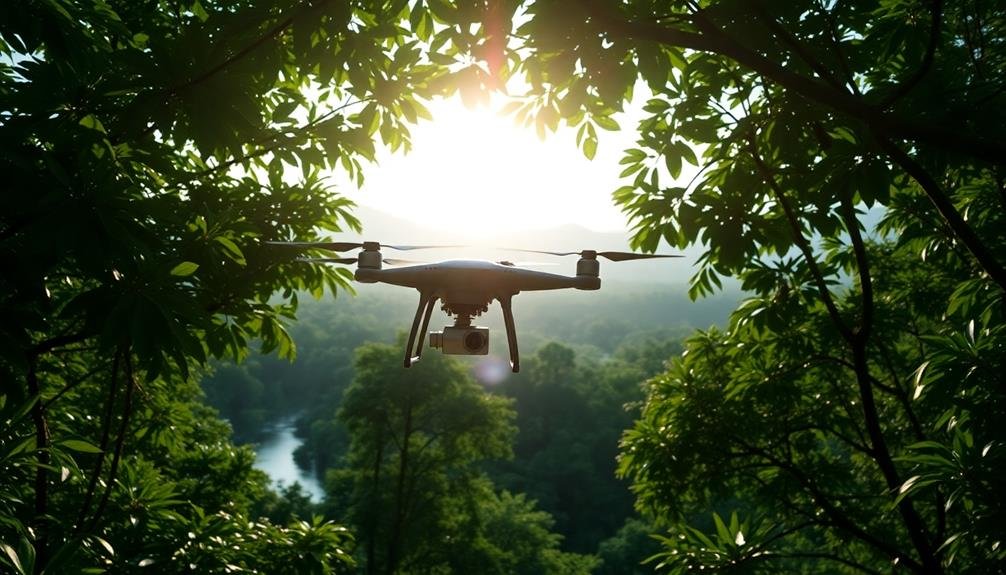
Beyond cost-effectiveness, airborne sensors excel at reaching areas that traditional ground-based methods can't access. You'll find these sensors particularly useful for monitoring remote, dangerous, or expansive locations. Think of steep mountain slopes, dense forests, or vast wetlands where ground access is limited or risky.
Airborne sensors can quickly cover large areas, providing a thorough view of environmental conditions. They're ideal for evaluating disaster zones, like flooded regions or wildfire-affected areas, where immediate data is essential but physical access is restricted. You can deploy them to monitor air quality in urban canyons, evaluate pollution levels over industrial complexes, or track wildlife in inaccessible habitats.
These sensors also shine in time-sensitive situations. You can rapidly deploy them to gather data on evolving environmental threats, such as chemical spills or volcanic eruptions. They're invaluable for monitoring changes in glaciers, ice sheets, and other climate-sensitive regions that are difficult to study on foot.
High-Resolution Mapping Capabilities
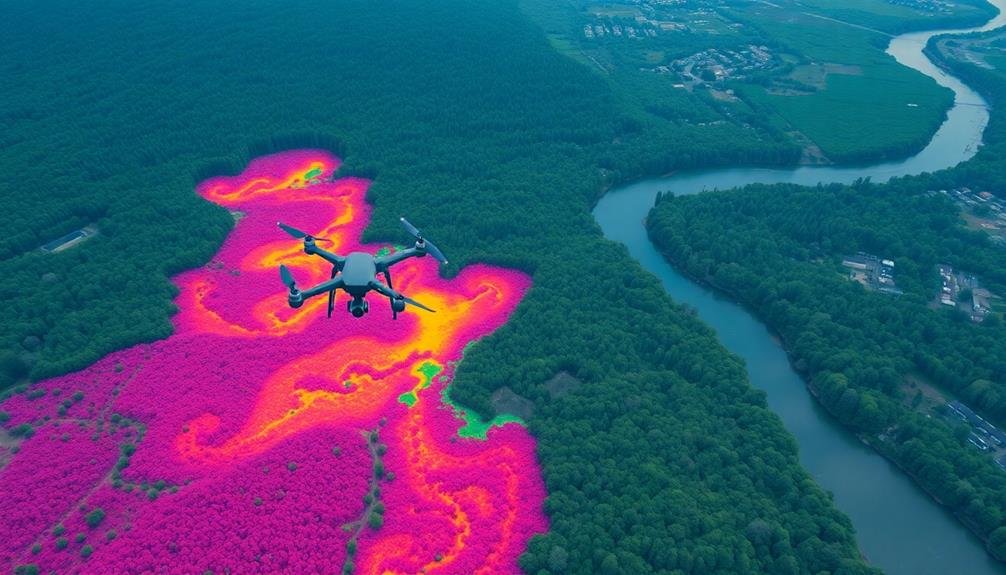
You'll find that airborne sensors excel at high-resolution mapping capabilities, offering efficient coverage of wide areas in a fraction of the time needed for ground-based methods.
These sensors can collect precise spatial data, allowing you to create detailed maps and models of environmental conditions across large regions.
They're particularly effective for terrain-independent data acquisition, capturing information from diverse landscapes that may be challenging or impossible to access on foot.
Wide-Area Coverage Efficiency
With airborne sensors, wide-area coverage efficiency has become a game-changer for environmental health assessments.
You'll find that these sensors can quickly scan vast regions, providing thorough data in a fraction of the time it would take using traditional ground-based methods. This efficiency allows for rapid response to environmental threats and more frequent monitoring of large ecosystems.
You'll appreciate the benefits of wide-area coverage when conducting environmental health assessments:
- Time savings: Cover extensive areas in hours instead of days or weeks
- Cost-effectiveness: Reduce labor and equipment costs associated with ground surveys
- Accessibility: Gather data from remote or hazardous locations without risking personnel safety
- Consistency: Guarantee uniform data collection across diverse landscapes
Precise Spatial Data Collection
Airborne sensors offer three key advantages in precise spatial data collection for environmental health assessments. First, they provide high-resolution mapping capabilities, allowing you to capture detailed imagery and data across large areas. You'll be able to identify small-scale environmental features and changes that might be missed by ground-based methods.
Second, airborne sensors enable 3D mapping and terrain modeling. This gives you an extensive view of the landscape, including elevation changes, vegetation density, and urban structures. You can use this information to analyze air pollution dispersion, water flow patterns, and habitat fragmentation.
Third, these sensors offer multi-spectral and hyperspectral imaging capabilities. You'll be able to detect and measure various environmental parameters simultaneously, including:
| Parameter | Application | Benefit |
|---|---|---|
| Vegetation health | Crop monitoring | Early disease detection |
| Water quality | Algal bloom tracking | Timely intervention |
| Air pollution | Emissions mapping | Source identification |
Terrain-Independent Data Acquisition
In spite of challenging terrains, airborne sensors excel at capturing high-resolution data across diverse landscapes. You'll find these sensors can operate effectively over mountains, forests, wetlands, and urban areas, providing consistent data quality regardless of ground conditions.
This terrain-independent capability guarantees you're not limited by inaccessible or dangerous locations when conducting environmental health assessments.
Airborne sensors offer high-resolution mapping capabilities that surpass traditional ground-based methods. You'll benefit from:
- Extensive coverage of large areas in a short time
- Ability to capture data from multiple angles and elevations
- Minimal disturbance to sensitive ecosystems or protected areas
- Rapid deployment for time-sensitive assessments, such as natural disasters
Versatility of Sensor Payloads
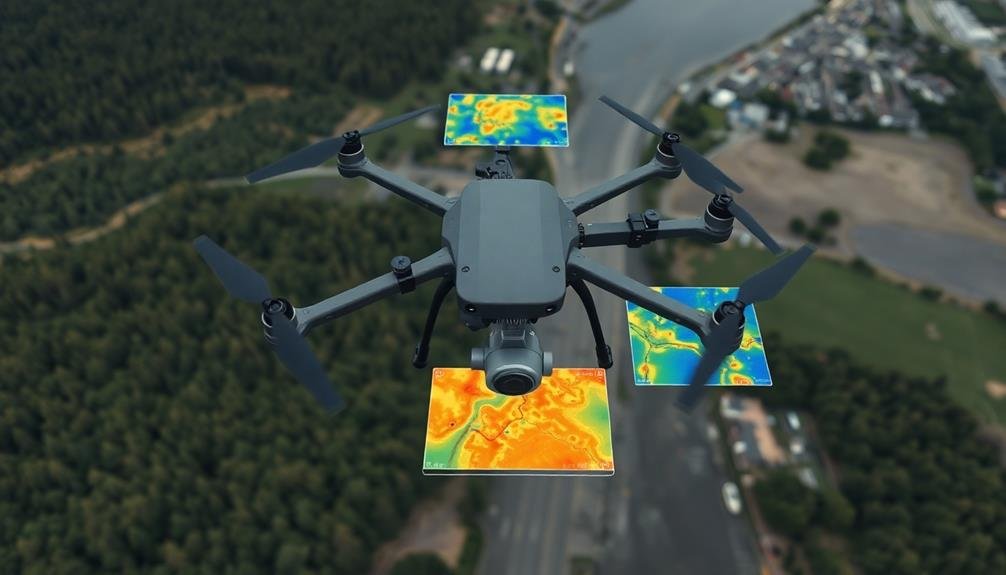
The versatility of sensor payloads is a key advantage of airborne environmental monitoring systems. You can equip aerial platforms with a wide range of sensors to collect diverse data types simultaneously. These may include optical cameras, multispectral and hyperspectral imagers, thermal sensors, LiDAR, and gas analyzers. This flexibility allows you to tailor your data collection to specific environmental health concerns.
You'll find that different sensor combinations can address various research questions. For instance, you can pair thermal cameras with gas sensors to detect methane leaks from pipelines. Or, you might combine multispectral imaging with LiDAR to assess vegetation health and structure. The ability to swap out sensors quickly means you can adapt to changing monitoring needs without significant downtime.
Moreover, you can integrate new sensor technologies as they become available, keeping your monitoring capabilities up-to-date. This adaptability guarantees that your airborne system remains relevant and effective over time.
Temporal and Spatial Flexibility
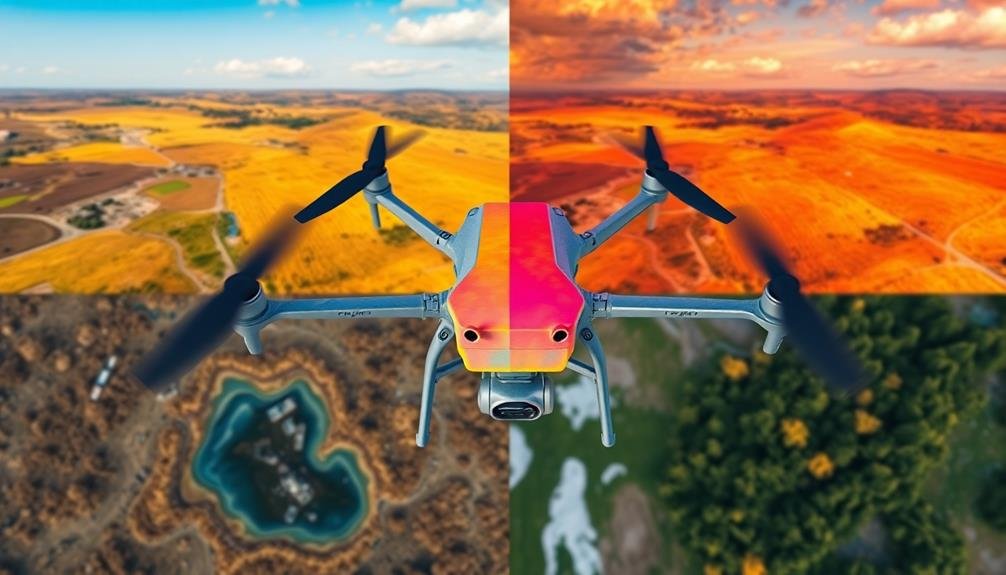
Flexibility in both time and space sets airborne environmental monitoring apart from traditional methods. You'll find that airborne sensors can be deployed quickly and efficiently, allowing you to capture data at specific times and locations of interest. This adaptability is essential when you're dealing with rapidly changing environmental conditions or emerging health concerns.
With airborne sensors, you're not limited to fixed monitoring stations. You can:
- Quickly respond to environmental emergencies
- Monitor seasonal variations in air quality
- Track pollutant dispersal patterns in real-time
- Assess the impact of specific events or activities on air quality
You'll appreciate the ability to adjust flight paths and altitudes on the fly, giving you a three-dimensional view of environmental conditions. This spatial flexibility allows you to collect data from hard-to-reach areas or across large geographic regions in a single mission.
Moreover, you can schedule repeat flights to capture temporal changes, providing valuable insights into long-term trends and short-term fluctuations. This temporal and spatial flexibility empowers you to make informed decisions about environmental health risks and implement targeted interventions more effectively than ever before.
Minimal Environmental Disturbance

Unlike traditional ground-based monitoring methods, airborne sensors offer a significant advantage in minimizing environmental disturbance. You'll find that these sensors can collect data without physically altering the landscape or disturbing wildlife habitats. This non-invasive approach is essential when studying sensitive ecosystems or protected areas.
Airborne sensors allow you to gather information from a distance, reducing the need for on-site personnel and equipment. You'll be able to monitor large areas without leaving footprints, crushing vegetation, or interfering with animal behavior. This is particularly valuable in fragile environments where human presence could skew results or cause unintended harm.
| Aspect | Ground-based Methods | Airborne Sensors |
|---|---|---|
| Habitat Disturbance | High | Minimal |
| Soil Compaction | Significant | None |
| Vegetation Damage | Possible | Unlikely |
| Wildlife Stress | Moderate | Low |
| Human Presence | Prolonged | Brief or None |
Frequently Asked Questions
What Are the Legal Regulations for Using Airborne Sensors in Environmental Monitoring?
You'll need to comply with aviation regulations, privacy laws, and environmental monitoring standards. Check local, state, and federal rules for drone usage, data collection, and reporting. Don't forget to obtain necessary permits before deploying airborne sensors.
How Accurate Are Airborne Sensors Compared to Ground-Based Monitoring Methods?
You'll find airborne sensors can be highly accurate, often matching or surpassing ground-based methods. They offer wider coverage and can access hard-to-reach areas. However, their accuracy can vary depending on factors like altitude and weather conditions.
Can Airborne Sensors Detect Specific Pollutants or Contaminants in the Environment?
Yes, airborne sensors can detect specific pollutants and contaminants. You'll find they're capable of identifying various substances like greenhouse gases, particulate matter, and chemical compounds. They're particularly useful for monitoring air quality and tracking environmental changes over large areas.
What Training Is Required to Operate and Interpret Data From Airborne Sensors?
You'll need specialized training to operate and interpret airborne sensor data. It'll typically involve courses on sensor operation, data analysis software, and environmental science. Hands-on experience and ongoing professional development are essential for staying current with technologies.
How Do Weather Conditions Affect the Performance of Airborne Environmental Sensors?
You'll find that weather considerably impacts airborne sensors. Wind can alter flight paths and data accuracy. Rain interferes with optical sensors. Temperature affects sensor calibration. Humidity can cause condensation on equipment. Always consider weather when planning missions.
In Summary
You've seen how airborne sensors revolutionize environmental health assessments. They're efficient, cost-effective, and versatile tools that provide wide coverage and real-time data. You can access hard-to-reach areas, create high-resolution maps, and adapt to various monitoring needs. With minimal disturbance to the environment, you'll gather vital information flexibly across time and space. By embracing this technology, you're enhancing your ability to protect public health and the environment more effectively than ever before.

As educators and advocates for responsible drone use, we’re committed to sharing our knowledge and expertise with aspiring aerial photographers.
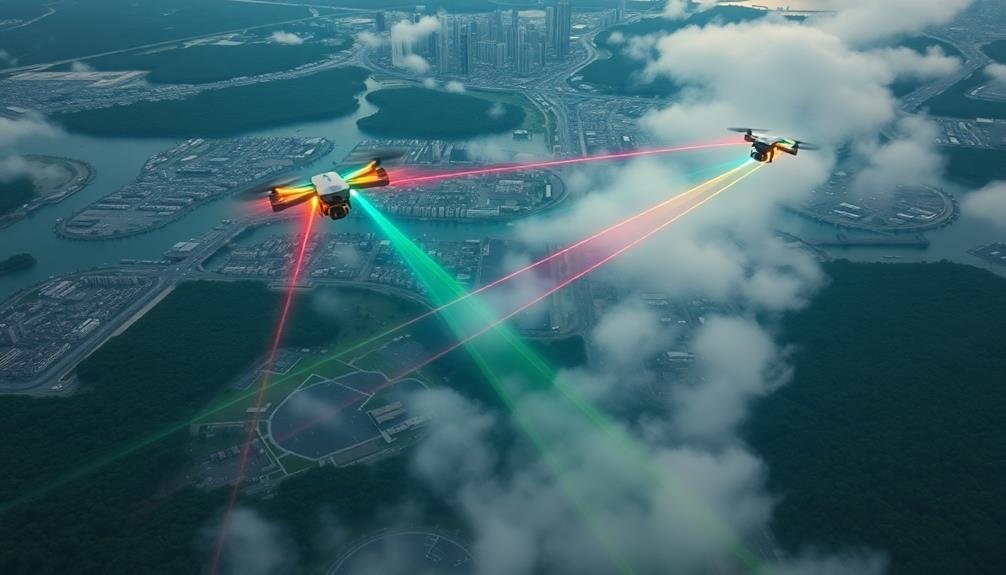



Leave a Reply